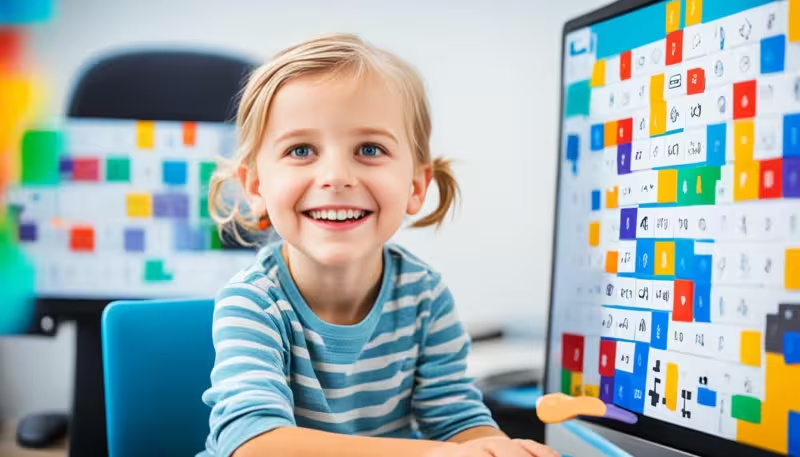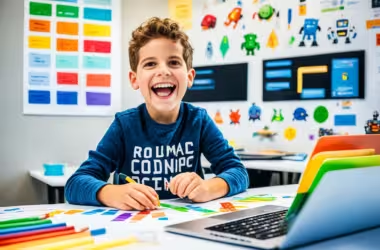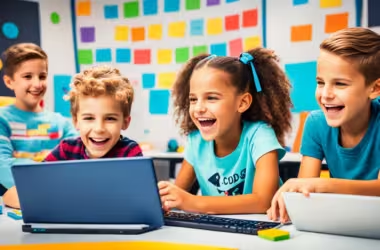How can coding kindle a love for learning in kids with dyslexia? This idea pushes us to look into coding as a fun way for kids who struggle with reading. Coding is an exciting path for about one in four children in the United States who deal with dyslexia.
It’s critical to find learning tools that are both innovative and fun. These tools should help bridge the education gap. By using educational technology in coding classes, we meet the unique needs of dyslexic learners. At the same time, we make programming interesting for them.
Interactive games and special apps are changing the game. They’re helping kids excel in an essential skill and making learning enjoyable, not scary.
Understanding Dyslexia and Its Impact on Learning
Dyslexia is common, affecting one in five kids. It makes reading and spelling hard, often due to word decoding issues. Kids with dyslexia struggle in school, especially with understanding texts and writing.
About 80 to 90 percent of children with learning disabilities have dyslexia. It affects both boys and girls the same way. Noticing the signs early is important. The right help can improve how well they do in school.
Dyslexia is a neurodevelopmental disorder. It’s known as a Specific Learning Disorder. It can cause frustration, shame, and skipping school activities. These feelings can harm a child’s self-esteem.
Using the right teaching methods is key to helping with dyslexia. Standard tutoring might not work without making learning enjoyable. Methods like The Wilson Method, The Orton-Gillingham Approach, and the Lindamood-Bell Program have been effective.
Adjustments for dyslexic students are important for their success in school. These include more time for tests, quiet areas for work, and allowing spoken answers. Finding and helping them early is essential for their progress.
Statistics on Dyslexia in the United States
In the United States, around 40 million adults face dyslexia. But, only about 2 million have been officially diagnosed. Dyslexia affects about 15% to 20% of students, making it a common learning challenge.
This condition represents a large part of learning disabilities in America. It’s estimated that 70% to 80% of people with poor reading skills might have dyslexia.
Dyslexia impacts both genders equally, with about 60% of cases found in males and females. It often runs in families, increasing the risk for children of dyslexic parents. Poverty also increases the risk, with a 40% higher chance of learning difficulties.
Studies show that around 38% of fourth-graders read below the expected level. Across the country, nearly 20% of elementary students struggle with reading.
The dropout rate for high schoolers with reading issues is about 62%. For those with individualized education plans, 89% have trouble reading. Specifically, 85% of them are diagnosed with dyslexia.
These facts show the urgent need for specialized education and support. The wide range of dyslexia rates, from less than 5% to 1 in 5, points to the challenge of diagnosing it. This affects how schools and policymaker’s act. With many people struggling with reading, targeted help is essential for better literacy.
Benefits of Coding for Kids with Dyslexia
Coding offers special benefits for children with dyslexia. It helps them think logically and solve problems creatively. Coding is more visual and interactive, helping dyslexic kids learn better.
Coding teaches kids how to figure out unknown words. They learn about vowel sounds and word parts. This helps them become more confident readers.
When kids code, they understand words and syllables better. Their reading skills grow. Coding makes learning fun, and kids feel proud of what they achieve.
Studies show that coding helps kids with dyslexia improve a lot. They get better at decoding words and spelling. Coding also boosts their confidence in reading and writing. It’s a key part of helping these kids learn more effectively.
Coding for Kids with Dyslexia: Fun Learning Tools
Learning tools can greatly help kids with dyslexia. Interactive games and coding apps make learning fun and effective. They improve phonemic awareness, vocabulary, and creativity. This makes the educational experience enjoyable and rewarding.
Interactive Games that Promote Essential Skills
Games like Word Witt help with spelling and phonics. Part of its sales goes to DyslexiaHelp, aiding more resources for dyslexic children. Draw Something lets kids practice word recall creatively. Websites such as ABCya, DyslexiaGames.com, and Math Playground offer fun educational games. These games keep kids interested in learning.
Apps Designed to Make Learning Fun
Coding apps match the learning needs of dyslexic children. Starfall teaches reading through systematic phonics, perfect for those with learning challenges. Scrabble and Word Central enhance spelling and vocabulary. For coding, Scratch and Blockly use block-based languages that are easy and visual. These make learning to code accessible and fun for kids.
Assistive Technology for Dyslexic Learners
Assistive technology helps dyslexic learners in their education. It tackles reading and writing problems. It also boosts their independence and confidence. Many tools support dyslexia, improving understanding, writing, and learning outcomes.
Text-to-Speech Tools
Text-to-speech (TTS) tech is key for dyslexia support. Voice Dream Reader allows for custom reading, aiding in comprehension. TTS tools cut down reading time and help understand the content. Audiobooks from Bookshare make reading fun and accessible for learners with differences.
Speech-to-Text Technology
Speech-to-text technology is essential for dyslexic students. Read & Write for Google Chrome lets students speak their thoughts instead of writing. It’s great for those who prefer talking over writing. It enhances writing skills and helps students express themselves clearly.
Educational Apps Beneficial for Dyslexic Children
Many educational apps are designed for children with dyslexia. They have special features to help with learning. These apps are not just fun; they also build skills like better vocabulary and spelling. Here are two apps that change how young users learn.
Word Witt: Enhancing Vocabulary and Spelling
Word Witt makes learning fun by focusing on vocabulary. It uses games to improve spelling and word recognition. The app helps through repetition, which is key for children with dyslexia. It strengthens their vocabulary, making it a great tool for learning.
ABCya: Games for Elementary Learning
ABCya is a top choice for educational games. It offers activities made by teachers for young students. The games are fun and match what kids learn in school. ABCya creates a positive space for dyslexic children to learn and have fun.
Online Platforms and Resources for Coding
Learning to code online can really help kids with dyslexia. Websites like PBS Kids and Starfall have special coding activities. They are made to be fun and easy for these kids to use.
PBS Kids and Starfall: Engaging Learning Experiences
PBS Kids offers lots of games that teach coding in a creative way. Kids can easily find their way around, trying out different coding games made just for them. It’s designed to grab the attention of kids with dyslexia with bright and interesting visuals.
Starfall helps kids learn to read with its phonics-based activities. It mixes stories and interactive elements to teach reading and coding. These platforms create a welcoming space for kids with dyslexia. They can learn coding at their own pace without getting frustrated.
Creative Learning Tools for Coding Skills
Creative tools in education make learning fun for everyone, especially students with dyslexia. These tools help improve coding skills. They also boost creativity and solving problems. Storytelling and visual aids greatly help how kids learn and share their ideas.
The Storymatic! Kids: Storytelling and Creativity
The Storymatic! Kids enhances storytelling and creativity. It encourages kids to make up their own stories. This builds important coding skills. It creates a space where kids use their imagination freely. This makes learning fun and deepens their coding understanding.
Inspiration Maps: Visual Learning Enhancements
Inspiration Maps are great for students with dyslexia. They offer graphic organizers to sort thoughts visually. These tools help kids brainstorm and plan coding projects easily. They make learning organized, helping all kinds of learners. This improves coding skills and project work.
Games that Promote Problem Solving and Logic
Games that help with problem-solving and logic are great for kids with dyslexia. There are many fun and educational games out there. They help players get better at vocabulary in a fun way. These activities are a cool way to work on logic skills needed for coding.
Words with Friends and Scrabble: Fun Spelling Games
Words with Friends and Scrabble are perfect for getting better at spelling, vocabulary, and thinking strategically. They are fun because they challenge you to make words and compete. Playing these games feels like the brain-challenges dyslexia brings, but in a fun way. Plus, you can play them for free on phones and tablets, so any family can use them.
Knoword: Vocabulary and Analytical Skills Booster
Knoword is a game that makes you think fast. You have to guess words from definitions and letters. It’s not just fun; it improves your vocabulary and quick thinking. Kids race to become the top Word Wizard while boosting their problem-solving skills. Games like this make it easier to deal with different learning challenges.
Encouragement and Support Resources for Parents
Parents of children with dyslexia play a key role. They provide support for dyslexic learners through encouragement and effective routines. It’s important to use parent resources for dyslexia to make a good learning space.
There are several tools to support a child’s learning. Using multisensory teaching methods helps the brain process information better. Child1st has been a leader since 2006, offering resources to help parents and teachers.
Some effective strategies include:
- Creating dedicated study spaces
- Using visual reminders like calendars and “to-do” lists
- Implementing routines that focus on short, consistent learning sessions
- Utilizing auditory teaching to link sounds and words better
Tools like pencil grips, colored markers, and tech can help in learning. Encouragement from parents boosts confidence and positivity towards education. Regular feedback and clear expectations are important for success.
Teaching others can help children understand better. It’s crucial for parents to adapt learning to fit their child’s needs and strengths. Using the right strategies and resources makes a big difference for dyslexic learners.
Conclusion
Coding for kids with dyslexia is not only helpful but also fun. It goes beyond learning to code. It helps with thinking, creativity, and solving problems. With special tools and support, we can help dyslexic kids grow confident and skilled.
There are many tools that help dyslexic kids with coding. They do more than teach coding. They help with organizing and remembering things. Kids learn a lot as they use these tools. They face challenges and celebrate their wins, growing personally.
We need to keep supporting these kids in their learning. By giving them the right tools, we help them do well in coding and other areas. This sets them up for success now and in the future.






